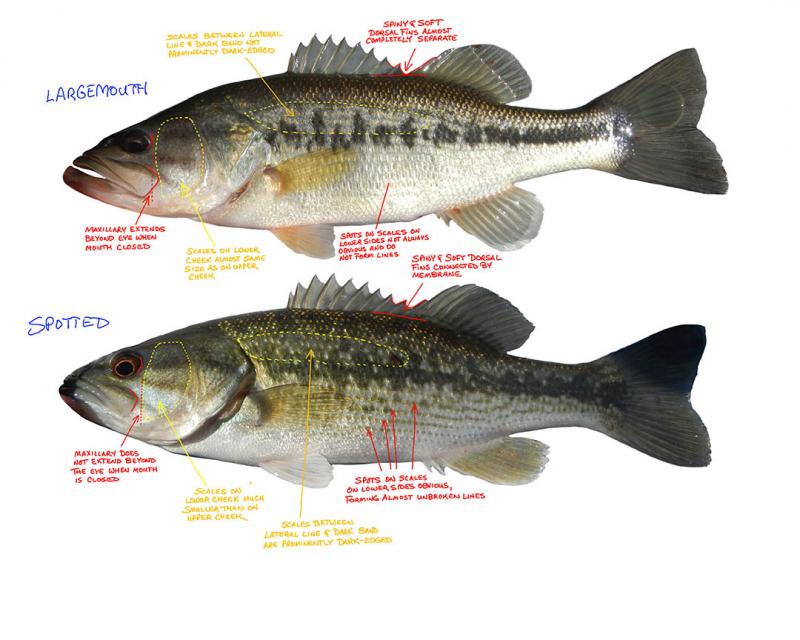Most of us who have caught a lot of both spotted bass and largemouth have become very good at telling them apart. I can tell what species it is while it’s still in the water if I’ve gotten a good look at it, and can tell at a glance once I lift it out of the water. But the differences are subtle to the inexperienced, or those who have not really made it a point to try to tell them apart. The tooth patch on the tongue is not a good indicator, because 10-20% of largemouth have a tooth patch, though it’s never as rough and prominent as on spotted bass; if it DOESN’T have a tooth patch, you know it’s a largemouth, but if it does, it MIGHT still be a largemouth. Overall coloration varies with water conditions and among individual fish, though spotted bass are usually a somewhat darker green on back and upper sides with a more brassy appearance on mid to lower sides, while largemouth are more gray-green. However, the cues that I use, now almost subconsciously, are the ones listed below. While fishing the other day, I caught a 10 inch largemouth and a 10 inch spot from the same waters, and took fairly careful photos of both. Below is the side by side comparison. Here are the big differences:
1. The spots on the scales on the lower sides. In largemouth, these spots may be present, but aren’t usually very obvious, and don’t connect to form darker lines. In spotted bass, they are almost always prominent and connect to form several thin dark lines.
2. The area between the lateral line (the sensory organ that forms a thin, often obscure line on the upper sides, following one row of scales) and the dark horizontal band that both species have. In spotted bass, the scales in this area are prominently dark-edged and obvious. In largemouth, they are not dark-edged and each scale is not very obvious. This gives the sides of the largemouth a “softness” or “smoothness” in the coloration, while the spotted bass are more “scaly” in appearance. It’s a subtle thing but easy to see once you look for it.
3. The scales on the cheeks. In largemouth, the scales on the lower cheeks are about as big as the scales on the upper cheeks, while in spotted bass the scales on the lower cheeks are much smaller than on the upper cheeks.
4. The membrane between spiny and soft dorsal fins. This one requires lifting the spines so that they are erect. When you do, the membrane behind the last spine of the spiny dorsal goes all the way down to the back in largemouth, making the two fins almost entirely separate. In spotted bass, that membrane connects the two fins pretty obviously.
5. And finally the maxillary (upper jaw). You have to close the mouth completely to check this, though you can also check it with mouth somewhat open by not looking at the maxillary itself but at the scaleless indentation where it fits into the cheek when the mouth is closed. In largemouth, the maxillary extends beyond the back edge of the eye. In spotted bass it extends about to the back edge or a little past the middle of the eye.
I hope this helps. I’ve seen most of these things pointed out in drawings of the fish, but seldom in real photos.












